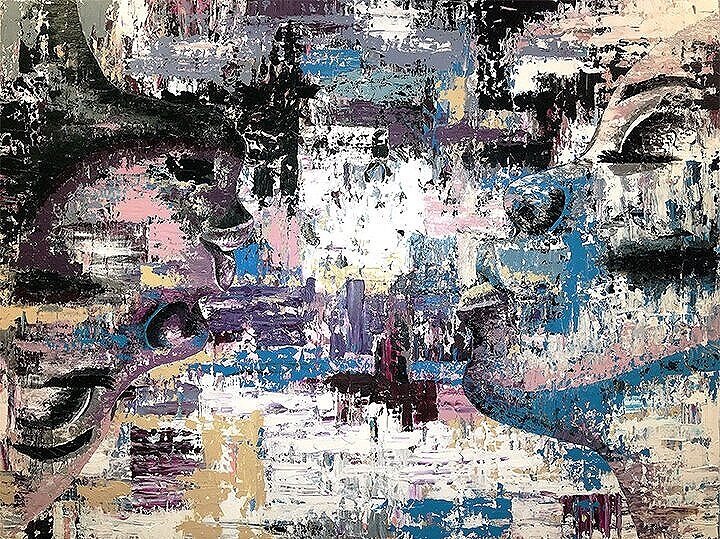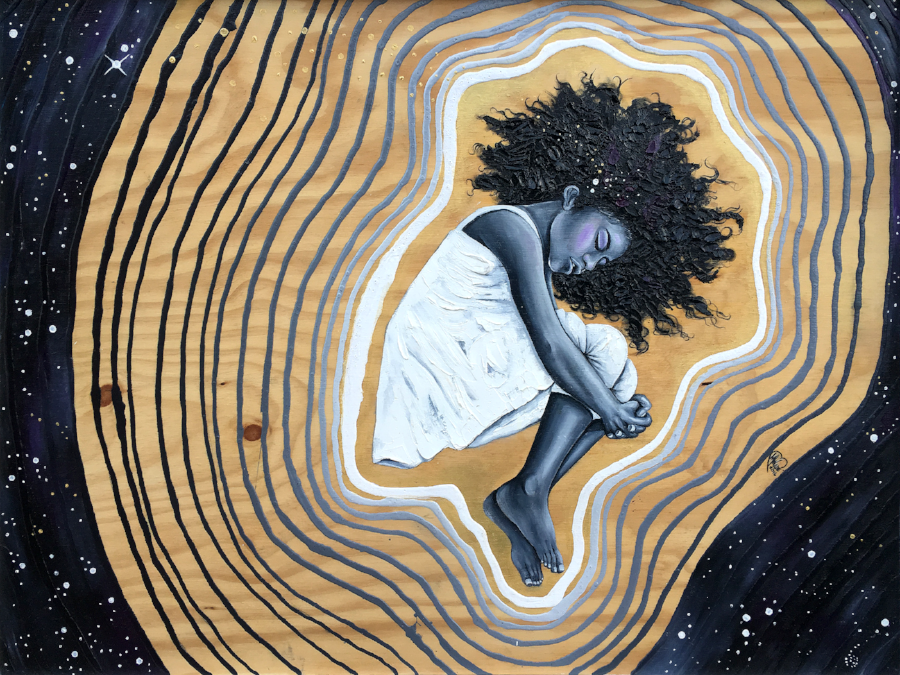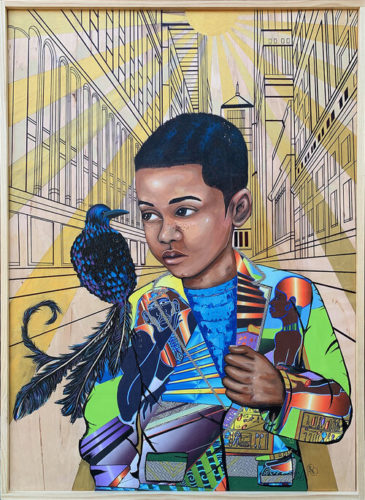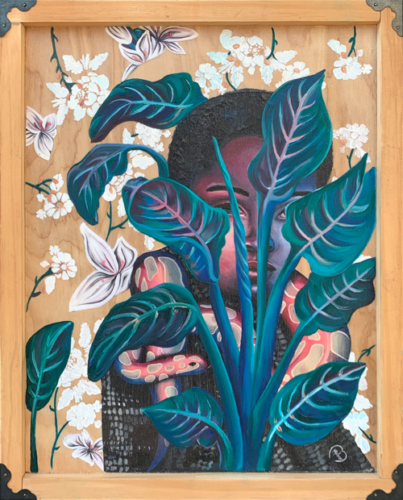Working in the arts scene for the past ten years, Martha A. Wade’s art seeks to immerse everyday experiences into the fantastical. As the daughter of artist Eugene “Eda” Wade—one of the pioneers of the 1960s Mural Movement in Chicago—she carries much of that legacy forward.
Wade works primarily in oil, acrylics, and mixed media on wood, often using collage to mix digital art, ink, and painting together. Through ethereal dreamscapes, star constellations, and vibrant colors, her artwork uplift people’s spirits and explore the connections between her subject’s interior selves and environments.
Using wood palettes to capture the skin tones of her subjects, her paintings depict Black people and people of color with beauty and strength. Some of her paintings feature children communing with spirit guides. Others show constellations dotting the night sky, her subjects untethered from the world below. Framed against the city, her subjects feel abstract and figurative, contemplative and full of life.
South Side Weekly spoke with Wade about her art practice, her creative process, and her long career as an artist and curator. This interview has been condensed and edited for clarity.
How do you describe yourself as an artist?
I’ve been painting for about ten years seriously. I grew up watching my father create art. He’s one of the artists that helped start the Mural Movement in the 1960s—Eugene “Eda” Wade. But I was scared of the starving artist stereotype. So I actually went to business school and had six different careers before I came about ten years ago and said, “No, I want to paint, I want to be an artist. This is what I want to do.”
When did you first become an artist? When did you know you wanted to start creating things?
I think that was five years old when I would pause cartoons and draw them, trying to draw every single character. I remember growing up watching my father create and working on these huge canvases and being like, “Wow, I want to do that,” but too young to have one of my own.
What influences your art and the things you like to paint?
Dreams influence my art. I am someone who’s a lucid dreamer. I’ll dream something, and I’ll remember it. So I’ve had dreams before that I’ll see a painting where it’s literally sprouting up things, and then I’ll paint that. I take a lot of pictures of my kids who are such great muses, and they’re such great models over the years. Then, everybody—movies, photos, books. I take a million photos as references.
What does your creative process look like?
The best way is where I bring it together in Photoshop, where I’m planning out my painting. I’ll have my reference in Photoshop and then start creating from there. I like to look at it first digitally, and then start to make the painting.
Now, I’m doing a lot of mixed media. I make my prints and collage that onto wood and then add paint on top of it. The collage started as a way to work smart, not hard—where I’m starting with my own painting that I’ve done. I make a print, I cut a piece of that out, [and] put it on wood. And now, I can color my own coloring book. My idea is to let me start with that and make something even greater from that.

Does spirituality inform or inspire your work?
I’m very spiritual. I’m not necessarily going to church every week, but the things [like] morals and thinking about a higher power or being open to the universe. So whatever you believe in—Buddha, God, Allah, the universe—I put all that in the work. I haven’t studied each one down to the last word, but I have studied several religions, and I find a lot of commonality among them, where they’re speaking to different groups of people. Maybe God is called a different thing, but it’s very similar—the notion that the absence of evidence is not evidence of absence. I put that overall theme in my work. A lot of the work has star constellations, so it’s all about dreaming, looking beyond yourself, looking out there…like what is out there?
What are your favorite pieces that you’ve gotten to work on?
I really like this piece called “Silent Preparation.” There’s a little boy, and part of his face is covered with plants. I’m a plant lover, so I incorporated that. Right now, I want to do art where the theme is connecting with yourself emotionally, physically, and mentally, but then also with nature—being grounded, appreciating plants, appreciating animals and other people.
Another favorite is called “Knowledge is Power.” It’s a boy with a bird on his shoulder. It’s a piece that my dad and I collaborated on together. This painting was my favorite of my dad’s. He did a print for me on canvas. I cut that out and collaged it onto the jacket of the boy, and it became a new piece.
You feature a lot of young people and people of color in your paintings. How does this empowerment drive your own work?
I started this series called Childhood Dreams & Conquered Fears. I’ve been working on this series for a long time, maybe six or seven years. My daughter was having issues because of her hair—it’s so beautiful. It’s big and curly, and so, she’s being teased at school, saying that her hair is too big. So I painted this piece called “Zora, The Conqueror” and it’s based on her and her big red hair with curls. I wanted her to see how beautiful she was and how beautiful her hair was.
Secondly, to combat a lot of the stereotypical things we see written about people of color, the fear, and the violence—showing the worst of us on TV. I wanted my art to combat that. I was imagining if people of all races would put images like this in their homes, how you could grow up seeing that and maybe start to see people of color in a positive light and not only listen to the backstories that are shown on the news and other social media and other platforms.
There are a lot of beautiful cityscapes in your work. What about Chicago inspires your art?
When I was younger, I wanted to be an architect, so some of that shows up in my work. I like order. I like the lines—it makes me feel calm or feel a sense of organization in the painting. I do like to pay homage to the city where I grew up and the city that I love. I definitely put cityscapes to show love to Chicago, but also the architecture is beautiful to me. I also feel like architects were the first artists before there was art for fun or figurative.
What are you most proud of with your work so far?
I’m proud of what I give to other artists. It’s not only about me, and I want to wrap them up and help other artists along the road as well, especially ones that maybe don’t like to deal with the business side. I love the community that we’ve cultivated in Chicago among the artists, and we now all help each other.
What do you hope people feel when they see your art?
I hope that they feel inspired and empowered to fulfill their dreams, especially young people looking at themselves and achieving things—whether it’s riding a bear, conquering your fears, or in a boat towards the city. I want people to see themselves as powerful and as beautiful and to feel good. And to feel empowered to go after what you want to do in your life.
Reema Saleh is a journalist and graduate student at the University of Chicago studying public policy. She last reviewed José Olivarez’s debut poetry collection Citizen Illegal.



